
Experimentos con redes neuronales (Parte 7): Transmitimos indicadores
Introducción
Buenas tardes, estimados usuarios de la comunidad MQL5. Hoy hablaremos con mayor detalle sobre la importancia de transmitir datos significativos, las llamadas series temporales, a una red neuronal. En mis artículos anteriores sobre experimentos con redes neuronales, mencioné esto repetidamente.
Hoy comenzaremos un nuevo capítulo y pasaremos directamente a la transmisión de todos nuestros indicadores favoritos. Haremos esto de manera significativa introduciendo algunos conceptos nuevos que utilizo en mi trabajo con redes neuronales. Aunque creo que este no es el límite y, con el tiempo, tendremos una nueva visión para comprender qué es exactamente lo que se debe transmitir y cómo. Pero por ahora tenemos lo que tenemos y trabajaremos con ello. Vamos allá.
Antecedentes y observaciones
La lectura de numerosos artículos sobre este tema deja ver constantemente una imagen bastante triste en los resultados directos de los sistemas comerciales basados en redes neuronales. Muchas ideas y algoritmos muy buenos no ofrecen los resultados deseados.
Siempre se observa la misma imagen en la transmisión de parámetros de entrada. Por ejemplo, la transmisión directa de los valores de los indicadores osciladores, que, en mi opinión, no tienen nada que ver con el precio de un activo. Los osciladores tienen un problema bien conocido, la llamada divergencia. Estos son los valores de los precios de apertura, cierre, máximo y mínimo que, cuando se transmiten directamente, no tienen ningún significado, pero llevan al sistema un ruido incomprensible con el cual intentamos entrenar dichos sistemas. Estos valores no están vinculados a nada y tienen una importante extensión en el tiempo. Como ejemplo, podemos abrir el gráfico diario de cualquier par de divisas y observar el rango de fluctuaciones del precio de cierre.
Teoría y conceptos
En esta sección veremos algunos de los conceptos que he clasificado y uso en mis experimentos.
- Distancias: distancias de cualquier indicador a otro indicador o su valor cero. El principio fundamental, en mi opinión, consiste en vincular la situación actual a un valor estable en la historia. Si transmitimos el valor directo del indicador MA 1, obtendremos una extensión de muestra incomprensible, ya que el valor del precio cambia con el tiempo y no se ha "desplazado" en un rango determinado, lo que presupone la clasificación o el más mínimo indicio de comportamiento estadístico. Otra cosa es cuando expresamos la diferencia entre dos indicadores MA 1 y MA 100, digamos, en puntos. O la distancia actual en la vela cero del indicador MACD con su valor de hace 4 velas. Por ello, al utilizar distancias, podemos determinar si el mercado se ha alejado de su promedio. ¿Está fuertemente sobrecomprado o sobrevendido en comparación con la muestra histórica en el momento actual? Además, utilizando la distancia, podemos determinar hacia dónde se mueve el mercado: hacia arriba o hacia abajo; el valor puede ser un número positivo o negativo.
- Acumulación: es el cálculo del valor total de un indicador o indicadores entre sí o de su punto cero. O puntos de valor cero en algunos indicadores distintos de cero. Así, gracias a la acumulación, podemos determinar cuánto tiempo lleva un movimiento particular en una dirección determinada. Si la acumulación es pequeña, tal vez ya se haya puesto en marcha una consolidación, y viceversa, si la acumulación es grande, quizá haya una tendencia prolongada. La dirección depende del signo - o +. En otras palabras, los valores de acumulación no tienen grandes valores durante las "turbulencias" de consolidación, mientras que sí los tienen durante las tendencias.
- Ángulos de inclinación: el ángulo de inclinación actual del indicador es una muy buena manera de informar a la red neuronal sobre el movimiento impulsivo en el momento, o bien su ausencia y la disminución de la actividad en el instrumento. La capacidad de determinar los ángulos de inclinación de los indicadores para una determinada historia, por ejemplo, en 10 velas, ha demostrado su eficacia al analizar la situación actual en comparación con los resultados del muestreo histórico. Permítanme recordarles que mido los ángulos de inclinación en radianes, este es el único método que me conviene personalmente y no depende de la escala del gráfico.
Ejemplos
Ejemplos de uso de distancias:
- Transmisión de distancias en la vela cero actual. Indicador MA 1 relativo a MA 100. Indicador MACD en relación con sus valores actual y cero. El indicador CCI en relación con sus valores actual y cero.
#property copyright "2023, Roman Poshtar" #property link "https://www.mql5.com/ru/users/romanuch" #property strict #property version "1.0" input int x1 = 1; input int x2 = 1; input int x3 = 1; int handle_In1S1; int handle_In2S1; int handle_In3S1; int handle_In4S1; double ind_In1S1[]; double ind_In2S1[]; double ind_In3S1[]; double ind_In4S1[]; //+------------------------------------------------------------------+ //| | //+------------------------------------------------------------------+ int OnInit() { handle_In1S1=iMA(Symbol(),PERIOD_CURRENT,1,0,MODE_SMA,PRICE_CLOSE); //--- if the handle is not created if(handle_In1S1==INVALID_HANDLE) { return(INIT_FAILED); } //--- handle_In2S1=iMA(Symbol(),PERIOD_CURRENT,100,0,MODE_SMA,PRICE_CLOSE); //--- if the handle is not created if(handle_In2S1==INVALID_HANDLE) { return(INIT_FAILED); } //--- handle_In3S1=iMACD(Symbol(),PERIOD_CURRENT,12,26,9,PRICE_CLOSE); //--- if the handle is not created if(handle_In3S1==INVALID_HANDLE) { return(INIT_FAILED); } //--- handle_In4S1=iCCI(Symbol(),PERIOD_CURRENT,14,PRICE_CLOSE); //--- if the handle is not created if(handle_In4S1==INVALID_HANDLE) { return(INIT_FAILED); } //--- return(INIT_SUCCEEDED); } //+------------------------------------------------------------------+ //| Expert tick function | //+------------------------------------------------------------------+ void OnTick() { //--- get data from the three buffers of the i-Regr indicator ArraySetAsSeries(ind_In1S1,true); if(!iGetArray(handle_In1S1,0,0,1010,ind_In1S1)) { return; } //--- //--- get data from the three buffers of the i-Regr indicator ArraySetAsSeries(ind_In2S1,true); if(!iGetArray(handle_In2S1,0,0,1010,ind_In2S1)) { return; } //--- //--- get data from the three buffers of the i-Regr indicator ArraySetAsSeries(ind_In3S1,true); if(!iGetArray(handle_In3S1,0,0,1010,ind_In3S1)) { return; } //--- //--- get data from the three buffers of the i-Regr indicator ArraySetAsSeries(ind_In4S1,true); if(!iGetArray(handle_In4S1,0,0,1010,ind_In4S1)) { return; } //--- perceptron1(); } //+------------------------------------------------------------------+ //| The PERCEPRRON - a perceiving and recognizing function | //+------------------------------------------------------------------+ double perceptron1() { double w1 = x1 - 10.0; double w2 = x2 - 10.0; double w3 = x3 - 10.0; double a1 = ((ind_In1S1[0]-ind_In2S1[0])/Point()); double a2 = ind_In3S1[0]; double a3 = ind_In4S1[0]; Print("a1 = ", a1); Print("a2 = ", a2); Print("a3 = ", a3); Print("Perceptron = ", (w1 * a1 + w2 * a2 + w3 * a3)); Print(">>>>>>>>>>>>>>>>>>>>>>>>>>>>>>>>>>>>>>>>>"); return (w1 * a1 + w2 * a2 + w3 * a3); }
Información mostrada en el diario de registro:
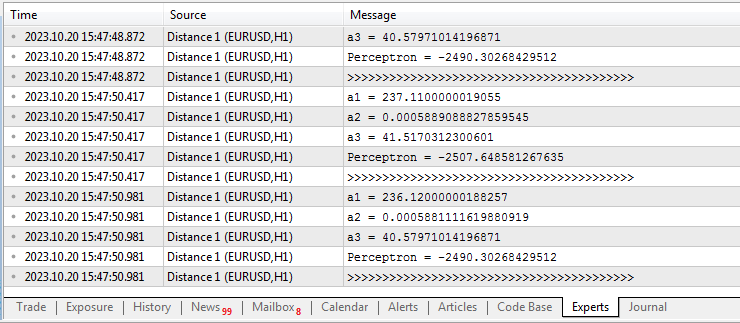
a1 - diferencia en puntos del par de divisas entre el indicador MA 1 y MA 100. Puede tomar valores tanto positivos como negativos.
a2 - valor actual del indicador MACD. Puede tomar valores tanto positivos como negativos.
a3 - valor actual del indicador CCI. Puede tomar valores tanto positivos como negativos.
- Transmisión de distancias N-números de velas hacia atrás. Indicador MA 1. Indicador MA 100. Indicador MACD. Indicador CCI.
#property copyright "2023, Roman Poshtar" #property link "https://www.mql5.com/ru/users/romanuch" #property strict #property version "1.0" input int Candles= 10; input int x1 = 1; input int x2 = 1; input int x3 = 1; input int x4 = 1; int handle_In1S1; int handle_In2S1; int handle_In3S1; int handle_In4S1; double ind_In1S1[]; double ind_In2S1[]; double ind_In3S1[]; double ind_In4S1[]; //+------------------------------------------------------------------+ //| | //+------------------------------------------------------------------+ int OnInit() { handle_In1S1=iMA(Symbol(),PERIOD_CURRENT,1,0,MODE_SMA,PRICE_CLOSE); //--- if the handle is not created if(handle_In1S1==INVALID_HANDLE) { return(INIT_FAILED); } //--- handle_In2S1=iMA(Symbol(),PERIOD_CURRENT,100,0,MODE_SMA,PRICE_CLOSE); //--- if the handle is not created if(handle_In2S1==INVALID_HANDLE) { return(INIT_FAILED); } //--- handle_In3S1=iMACD(Symbol(),PERIOD_CURRENT,12,26,9,PRICE_CLOSE); //--- if the handle is not created if(handle_In3S1==INVALID_HANDLE) { return(INIT_FAILED); } //--- handle_In4S1=iCCI(Symbol(),PERIOD_CURRENT,14,PRICE_CLOSE); //--- if the handle is not created if(handle_In4S1==INVALID_HANDLE) { return(INIT_FAILED); } //--- return(INIT_SUCCEEDED); } //+------------------------------------------------------------------+ //| Expert tick function | //+------------------------------------------------------------------+ void OnTick() { //--- get data from the three buffers of the i-Regr indicator ArraySetAsSeries(ind_In1S1,true); if(!iGetArray(handle_In1S1,0,0,1010,ind_In1S1)) { return; } //--- //--- get data from the three buffers of the i-Regr indicator ArraySetAsSeries(ind_In2S1,true); if(!iGetArray(handle_In2S1,0,0,1010,ind_In2S1)) { return; } //--- //--- get data from the three buffers of the i-Regr indicator ArraySetAsSeries(ind_In3S1,true); if(!iGetArray(handle_In3S1,0,0,1010,ind_In3S1)) { return; } //--- //--- get data from the three buffers of the i-Regr indicator ArraySetAsSeries(ind_In4S1,true); if(!iGetArray(handle_In4S1,0,0,1010,ind_In4S1)) { return; } //--- perceptron1(); } //+------------------------------------------------------------------+ //| The PERCEPRRON - a perceiving and recognizing function | //+------------------------------------------------------------------+ double perceptron1() { double w1 = x1 - 10.0; double w2 = x2 - 10.0; double w3 = x3 - 10.0; double w4 = x4 - 10.0; double a1 = ((ind_In1S1[0]-ind_In1S1[Candles])/Point()); double a2 = ((ind_In2S1[0]-ind_In2S1[Candles])/Point()); double a3 = ind_In3S1[0]-ind_In3S1[Candles]; double a4 = ind_In4S1[0]-ind_In4S1[Candles]; Print("a1 = ", a1); Print("a2 = ", a2); Print("a3 = ", a3); Print("a3 = ", a4); Print("Perceptron = ", (w1 * a1 + w2 * a2 + w3 * a3 + w4 * a4)); Print(">>>>>>>>>>>>>>>>>>>>>>>>>>>>>>>>>>>>>>>>>"); return (w1 * a1 + w2 * a2 + w3 * a3 + w4 * a4); }
Información mostrada en el diario de registro:

a1 - diferencia en puntos de un par de divisas utilizando el indicador MA 1 en la vela 0 y la vela 10. Puede tomar valores tanto positivos como negativos.
a2 - diferencia en puntos de un par de divisas utilizando el indicador MA 100 en la vela 0 y la vela 10. Puede tomar valores tanto positivos como negativos.
a3 - diferencia en el valor del indicador MACD en la vela 0 y la vela 10. Puede tomar valores tanto positivos como negativos.
a4 - diferencia en el valor del indicador CCI en la vela 0 y la vela 10. Puede tomar valores tanto positivos como negativos.
- Transmisión de distancias desde el punto de intersección de los indicadores MA1 y MA 100 con respecto a su valor cero en el pasado. Indicador MACD en relación con su valor cero en el pasado. Indicador CCI en relación con su valor cero en el pasado.
#property copyright "2023, Roman Poshtar" #property link "https://www.mql5.com/ru/users/romanuch" #property strict #property version "1.0" input int Candles= 10; input int x1 = 1; input int x2 = 1; input int x3 = 1; input int x4 = 1; int handle_In1S1; int handle_In2S1; int handle_In3S1; int handle_In4S1; double ind_In1S1[]; double ind_In2S1[]; double ind_In3S1[]; double ind_In4S1[]; //+------------------------------------------------------------------+ //| | //+------------------------------------------------------------------+ int OnInit() { handle_In1S1=iMA(Symbol(),PERIOD_CURRENT,1,0,MODE_SMA,PRICE_CLOSE); //--- if the handle is not created if(handle_In1S1==INVALID_HANDLE) { return(INIT_FAILED); } //--- handle_In2S1=iMA(Symbol(),PERIOD_CURRENT,100,0,MODE_SMA,PRICE_CLOSE); //--- if the handle is not created if(handle_In2S1==INVALID_HANDLE) { return(INIT_FAILED); } //--- handle_In3S1=iMACD(Symbol(),PERIOD_CURRENT,12,26,9,PRICE_CLOSE); //--- if the handle is not created if(handle_In3S1==INVALID_HANDLE) { return(INIT_FAILED); } //--- handle_In4S1=iCCI(Symbol(),PERIOD_CURRENT,14,PRICE_CLOSE); //--- if the handle is not created if(handle_In4S1==INVALID_HANDLE) { return(INIT_FAILED); } //--- return(INIT_SUCCEEDED); } //+------------------------------------------------------------------+ //| Expert tick function | //+------------------------------------------------------------------+ void OnTick() { //--- get data from the three buffers of the i-Regr indicator ArraySetAsSeries(ind_In1S1,true); if(!iGetArray(handle_In1S1,0,0,1010,ind_In1S1)) { return; } //--- //--- get data from the three buffers of the i-Regr indicator ArraySetAsSeries(ind_In2S1,true); if(!iGetArray(handle_In2S1,0,0,1010,ind_In2S1)) { return; } //--- //--- get data from the three buffers of the i-Regr indicator ArraySetAsSeries(ind_In3S1,true); if(!iGetArray(handle_In3S1,0,0,1010,ind_In3S1)) { return; } //--- //--- get data from the three buffers of the i-Regr indicator ArraySetAsSeries(ind_In4S1,true); if(!iGetArray(handle_In4S1,0,0,1010,ind_In4S1)) { return; } //--- perceptron1(); } //+------------------------------------------------------------------+ //| The PERCEPRRON - a perceiving and recognizing function | //+------------------------------------------------------------------+ double perceptron1() { int c1=0; int c2=0; int c3=0; double w1 = x1 - 10.0; double w2 = x2 - 10.0; double w3 = x3 - 10.0; double w4 = x4 - 10.0; for(int i=0; i<=1000; i++){ if(ind_In1S1[0]>ind_In2S1[0]){if (ind_In1S1[i]<ind_In2S1[i]){c1=i; break;}} if(ind_In1S1[0]<ind_In2S1[0]){if (ind_In1S1[i]>ind_In2S1[i]){c1=i; break;}} } double a1 = ((ind_In1S1[0]-ind_In1S1[c1])/Point()); double a2 = ((ind_In2S1[0]-ind_In2S1[c1])/Point()); for(int i=0; i<=1000; i++){ if(ind_In3S1[0]>0){if (ind_In3S1[i]<0){c2=i; break;}} if(ind_In3S1[0]<0){if (ind_In3S1[i]>0){c2=i; break;}} } double a3 = ind_In3S1[0]-ind_In3S1[c2]; for(int i=0; i<=1000; i++){ if(ind_In4S1[0]>0){if (ind_In4S1[i]<0){c3=i; break;}} if(ind_In4S1[0]<0){if (ind_In4S1[i]>0){c3=i; break;}} } double a4 = ind_In4S1[0]-ind_In4S1[c3]; Print("a1 = ", a1); Print("a2 = ", a2); Print("a3 = ", a3); Print("a4 = ", a4); Print("Perceptron = ", (w1 * a1 + w2 * a2 + w3 * a3 + w4 * a4)); Print(">>>>>>>>>>>>>>>>>>>>>>>>>>>>>>>>>>>>>>>>>"); return (w1 * a1 + w2 * a2 + w3 * a3 + w4 * a4); }
Información mostrada en el diario de registro:

a1 - diferencia en puntos del par de divisas entre el indicador MA 1 en la vela 0 y la vela donde estuvo la última intersección de los indicadores MA1 y MA 100. Puede tomar valores tanto positivos como negativos.
a2 - diferencia en puntos del par de divisas con el indicador MA 100 en la vela 0 y la vela donde estuvo la última intersección de los indicadores MA1 y MA 100. Puede tomar valores tanto positivos como negativos.
a3 - diferencia entre el valor del indicador MACD en la vela 0 y la vela donde estuvo la última intersección con el valor 0. Puede tomar valores tanto positivos como negativos.
a4 - diferencia entre el valor del indicador CCI en la vela 0 y la vela donde estuvo la última intersección con el valor 0. Puede tomar valores tanto positivos como negativos.
La búsqueda del valor de intersección se realiza primero en un ciclo.
Ejemplos de uso de la acumulación para la transmisión a un perceptrón:
- Transmisión de acumulación para N-número de velas indicadoras.
#property copyright "2023, Roman Poshtar" #property link "https://www.mql5.com/ru/users/romanuch" #property strict #property version "1.0" input int Candles= 10; input int x1 = 1; input int x2 = 1; input int x3 = 1; int handle_In1S1; int handle_In2S1; int handle_In3S1; int handle_In4S1; double ind_In1S1[]; double ind_In2S1[]; double ind_In3S1[]; double ind_In4S1[]; //+------------------------------------------------------------------+ //| | //+------------------------------------------------------------------+ int OnInit() { handle_In1S1=iMA(Symbol(),PERIOD_CURRENT,1,0,MODE_SMA,PRICE_CLOSE); //--- if the handle is not created if(handle_In1S1==INVALID_HANDLE) { return(INIT_FAILED); } //--- handle_In2S1=iMA(Symbol(),PERIOD_CURRENT,100,0,MODE_SMA,PRICE_CLOSE); //--- if the handle is not created if(handle_In2S1==INVALID_HANDLE) { return(INIT_FAILED); } //--- handle_In3S1=iMACD(Symbol(),PERIOD_CURRENT,12,26,9,PRICE_CLOSE); //--- if the handle is not created if(handle_In3S1==INVALID_HANDLE) { return(INIT_FAILED); } //--- handle_In4S1=iCCI(Symbol(),PERIOD_CURRENT,14,PRICE_CLOSE); //--- if the handle is not created if(handle_In4S1==INVALID_HANDLE) { return(INIT_FAILED); } //--- return(INIT_SUCCEEDED); } //+------------------------------------------------------------------+ //| Expert tick function | //+------------------------------------------------------------------+ void OnTick() { //--- get data from the three buffers of the i-Regr indicator ArraySetAsSeries(ind_In1S1,true); if(!iGetArray(handle_In1S1,0,0,1010,ind_In1S1)) { return; } //--- //--- get data from the three buffers of the i-Regr indicator ArraySetAsSeries(ind_In2S1,true); if(!iGetArray(handle_In2S1,0,0,1010,ind_In2S1)) { return; } //--- //--- get data from the three buffers of the i-Regr indicator ArraySetAsSeries(ind_In3S1,true); if(!iGetArray(handle_In3S1,0,0,1010,ind_In3S1)) { return; } //--- //--- get data from the three buffers of the i-Regr indicator ArraySetAsSeries(ind_In4S1,true); if(!iGetArray(handle_In4S1,0,0,1010,ind_In4S1)) { return; } //--- perceptron1(); } //+------------------------------------------------------------------+ //| The PERCEPRRON - a perceiving and recognizing function | //+------------------------------------------------------------------+ double perceptron1() { double sum1 = 0; double sum2 = 0; double sum3 = 0; double w1 = x1 - 10.0; double w2 = x2 - 10.0; double w3 = x3 - 10.0; for(int i=0; i<=Candles; i++) { sum1+=ind_In1S1[i]-ind_In2S1[i]; } double a1 = sum1; for(int i=0; i<=Candles; i++) { sum2+=ind_In3S1[i]; } double a2 = sum2; for(int i=0; i<=Candles; i++) { sum3+=ind_In4S1[i]; } double a3 = sum3; Print("a1 = ", a1); Print("a2 = ", a2); Print("a3 = ", a3); Print("Perceptron = ", (w1 * a1 + w2 * a2 + w3 * a3)); Print(">>>>>>>>>>>>>>>>>>>>>>>>>>>>>>>>>>>>>>>>>"); return (w1 * a1 + w2 * a2 + w3 * a3); }
Información mostrada en el diario de registro:
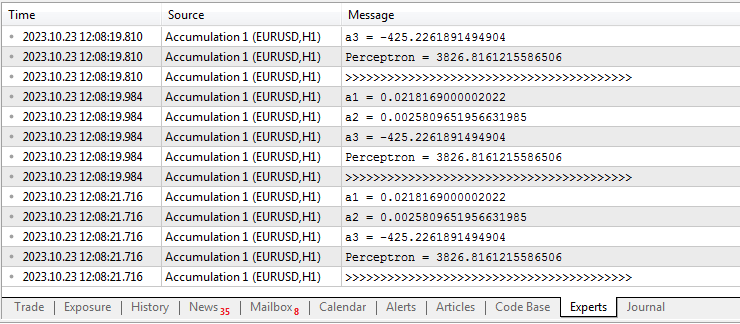
a1 - acumulación de la diferencia entre los indicadores MA1 y MA 100 para el número de velas del parámetro Candles. Puede tomar valores tanto positivos como negativos.
a2 - acumulación del indicador MACD para el número de velas del parámetro Candles. Puede tomar valores tanto positivos como negativos.
a3 - acumulación del indicador CCI para el número de velas del parámetro Candles. Puede tomar valores tanto positivos como negativos.
- Transmisión de la acumulación desde el punto cero del indicador en el pasado o la última intersección de los indicadores en el pasado.
#property copyright "2023, Roman Poshtar" #property link "https://www.mql5.com/ru/users/romanuch" #property strict #property version "1.0" input int Candles= 10; input int x1 = 1; input int x2 = 1; input int x3 = 1; int handle_In1S1; int handle_In2S1; int handle_In3S1; int handle_In4S1; double ind_In1S1[]; double ind_In2S1[]; double ind_In3S1[]; double ind_In4S1[]; //+------------------------------------------------------------------+ //| | //+------------------------------------------------------------------+ int OnInit() { handle_In1S1=iMA(Symbol(),PERIOD_CURRENT,1,0,MODE_SMA,PRICE_CLOSE); //--- if the handle is not created if(handle_In1S1==INVALID_HANDLE) { return(INIT_FAILED); } //--- handle_In2S1=iMA(Symbol(),PERIOD_CURRENT,100,0,MODE_SMA,PRICE_CLOSE); //--- if the handle is not created if(handle_In2S1==INVALID_HANDLE) { return(INIT_FAILED); } //--- handle_In3S1=iMACD(Symbol(),PERIOD_CURRENT,12,26,9,PRICE_CLOSE); //--- if the handle is not created if(handle_In3S1==INVALID_HANDLE) { return(INIT_FAILED); } //--- handle_In4S1=iCCI(Symbol(),PERIOD_CURRENT,14,PRICE_CLOSE); //--- if the handle is not created if(handle_In4S1==INVALID_HANDLE) { return(INIT_FAILED); } //--- return(INIT_SUCCEEDED); } //+------------------------------------------------------------------+ //| Expert tick function | //+------------------------------------------------------------------+ void OnTick() { //--- get data from the three buffers of the i-Regr indicator ArraySetAsSeries(ind_In1S1,true); if(!iGetArray(handle_In1S1,0,0,1010,ind_In1S1)) { return; } //--- //--- get data from the three buffers of the i-Regr indicator ArraySetAsSeries(ind_In2S1,true); if(!iGetArray(handle_In2S1,0,0,1010,ind_In2S1)) { return; } //--- //--- get data from the three buffers of the i-Regr indicator ArraySetAsSeries(ind_In3S1,true); if(!iGetArray(handle_In3S1,0,0,1010,ind_In3S1)) { return; } //--- //--- get data from the three buffers of the i-Regr indicator ArraySetAsSeries(ind_In4S1,true); if(!iGetArray(handle_In4S1,0,0,1010,ind_In4S1)) { return; } //--- perceptron1(); } //+------------------------------------------------------------------+ //| The PERCEPRRON - a perceiving and recognizing function | //+------------------------------------------------------------------+ double perceptron1() { double sum1 = 0; double sum2 = 0; double sum3 = 0; double w1 = x1 - 10.0; double w2 = x2 - 10.0; double w3 = x3 - 10.0; for(int i=0; i<=1000; i++) { if(ind_In1S1[0]>ind_In2S1[0]) { if(ind_In1S1[i]<ind_In2S1[i]) { break; }; sum1+=(ind_In1S1[i]-ind_In2S1[i]); } if(ind_In1S1[0]<ind_In2S1[0]) { if(ind_In1S1[i]>ind_In2S1[i]) { break; }; sum1+=(ind_In1S1[i]-ind_In2S1[i]); } } double a1 = sum1; for(int i=0; i<=1000; i++) { if(ind_In3S1[0]>0) { if(ind_In3S1[i]<0) { break; }; sum2+=ind_In3S1[i]; } if(ind_In3S1[0]<0) { if(ind_In3S1[i]>0) { break; }; sum2+=ind_In3S1[i]; } } double a2 = sum2; for(int i=0; i<=1000; i++) { if(ind_In4S1[0]>0) { if(ind_In4S1[i]<0) { break; }; sum3+=ind_In4S1[i]; } if(ind_In4S1[0]<0) { if(ind_In4S1[i]>0) { break; }; sum3+=ind_In4S1[i]; } } double a3 = sum3; Print("a1 = ", a1); Print("a2 = ", a2); Print("a3 = ", a3); Print("Perceptron = ", (w1 * a1 + w2 * a2 + w3 * a3)); Print(">>>>>>>>>>>>>>>>>>>>>>>>>>>>>>>>>>>>>>>>>"); return (w1 * a1 + w2 * a2 + w3 * a3); }
Información mostrada en el diario de registro:
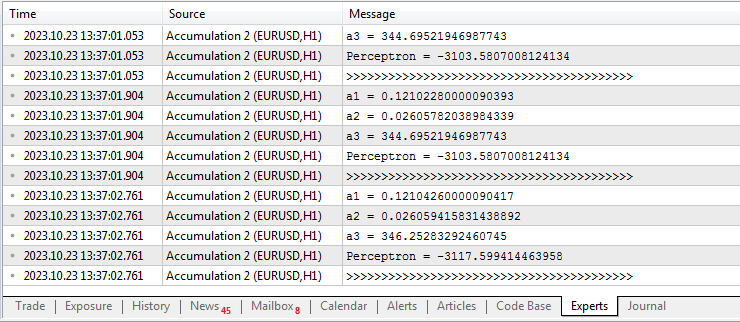
a1 - acumulación de la diferencia entre los indicadores MA1 y MA 100 desde el punto de la última intersección. Puede tomar valores tanto positivos como negativos.
a2 - acumulación del indicador MACD desde el punto de la última intersección del valor 0. Puede tomar valores tanto positivos como negativos.
a3 - acumulación del indicador CCI desde el punto de la última intersección del valor 0. Puede tomar valores tanto positivos como negativos.
Ejemplos de uso de los ángulos de inclinación de los indicadores:
- Transmisión de los ángulos de inclinación para N-número de velas indicadoras.
#property copyright "2023, Roman Poshtar" #property link "https://www.mql5.com/ru/users/romanuch" #property strict #property version "1.0" input int Candles= 10; input int x1 = 1; input int x2 = 1; input int x3 = 1; input int x4 = 1; int handle_In1S1; int handle_In2S1; int handle_In3S1; int handle_In4S1; double ind_In1S1[]; double ind_In2S1[]; double ind_In3S1[]; double ind_In4S1[]; //+------------------------------------------------------------------+ //| | //+------------------------------------------------------------------+ int OnInit() { handle_In1S1=iMA(Symbol(),PERIOD_CURRENT,1,0,MODE_SMA,PRICE_CLOSE); //--- if the handle is not created if(handle_In1S1==INVALID_HANDLE) { return(INIT_FAILED); } //--- handle_In2S1=iMA(Symbol(),PERIOD_CURRENT,100,0,MODE_SMA,PRICE_CLOSE); //--- if the handle is not created if(handle_In2S1==INVALID_HANDLE) { return(INIT_FAILED); } //--- handle_In3S1=iMACD(Symbol(),PERIOD_CURRENT,12,26,9,PRICE_CLOSE); //--- if the handle is not created if(handle_In3S1==INVALID_HANDLE) { return(INIT_FAILED); } //--- handle_In4S1=iCCI(Symbol(),PERIOD_CURRENT,14,PRICE_CLOSE); //--- if the handle is not created if(handle_In4S1==INVALID_HANDLE) { return(INIT_FAILED); } //--- return(INIT_SUCCEEDED); } //+------------------------------------------------------------------+ //| Expert tick function | //+------------------------------------------------------------------+ void OnTick() { //--- get data from the three buffers of the i-Regr indicator ArraySetAsSeries(ind_In1S1,true); if(!iGetArray(handle_In1S1,0,0,1010,ind_In1S1)) { return; } //--- //--- get data from the three buffers of the i-Regr indicator ArraySetAsSeries(ind_In2S1,true); if(!iGetArray(handle_In2S1,0,0,1010,ind_In2S1)) { return; } //--- //--- get data from the three buffers of the i-Regr indicator ArraySetAsSeries(ind_In3S1,true); if(!iGetArray(handle_In3S1,0,0,1010,ind_In3S1)) { return; } //--- //--- get data from the three buffers of the i-Regr indicator ArraySetAsSeries(ind_In4S1,true); if(!iGetArray(handle_In4S1,0,0,1010,ind_In4S1)) { return; } //--- perceptron1(); } //+------------------------------------------------------------------+ //| The PERCEPRRON - a perceiving and recognizing function | //+------------------------------------------------------------------+ double perceptron1() { double w1 = x1 - 10.0; double w2 = x2 - 10.0; double w3 = x3 - 10.0; double w4 = x4 - 10.0; double a1 = (((ind_In1S1[0]-ind_In1S1[Candles])/Point())/Candles); double a2 = (((ind_In2S1[0]-ind_In2S1[Candles])/Point())/Candles); double a3 = ((ind_In3S1[0]-ind_In3S1[Candles])/Candles); double a4 = ((ind_In4S1[0]-ind_In4S1[Candles])/Candles); Print("a1 = ", a1); Print("a2 = ", a2); Print("a3 = ", a3); Print("a4 = ", a4); Print("Perceptron = ", (w1 * a1 + w2 * a2 + w3 * a3 + w4 * a4)); Print(">>>>>>>>>>>>>>>>>>>>>>>>>>>>>>>>>>>>>>>>>"); return (w1 * a1 + w2 * a2 + w3 * a3 + w4 * a4); }
Información mostrada en el diario de registro:

a1 - ángulo de inclinación del indicador MA1 para el número de velas del parámetro Candles. Puede tomar valores tanto positivos como negativos.
a2 - ángulo de inclinación del indicador MA100 para el número de velas del parámetro Candles. Puede tomar valores tanto positivos como negativos.
a3 - ángulo de inclinación del indicador MACD para el número de velas del parámetro Candles. Puede tomar valores tanto positivos como negativos.
a4: el ángulo de inclinación del indicador CCI para el número de velas del parámetro Candles. Puede tomar valores tanto positivos como negativos.
- Transmisión de los ángulos de inclinación desde el punto cero del indicador en el pasado o la última intersección de los indicadores en el pasado.
#property copyright "2023, Roman Poshtar" #property link "https://www.mql5.com/ru/users/romanuch" #property strict #property version "1.0" input int x1 = 1; input int x2 = 1; input int x3 = 1; input int x4 = 1; int handle_In1S1; int handle_In2S1; int handle_In3S1; int handle_In4S1; double ind_In1S1[]; double ind_In2S1[]; double ind_In3S1[]; double ind_In4S1[]; //+------------------------------------------------------------------+ //| | //+------------------------------------------------------------------+ int OnInit() { handle_In1S1=iMA(Symbol(),PERIOD_CURRENT,1,0,MODE_SMA,PRICE_CLOSE); //--- if the handle is not created if(handle_In1S1==INVALID_HANDLE) { return(INIT_FAILED); } //--- handle_In2S1=iMA(Symbol(),PERIOD_CURRENT,100,0,MODE_SMA,PRICE_CLOSE); //--- if the handle is not created if(handle_In2S1==INVALID_HANDLE) { return(INIT_FAILED); } //--- handle_In3S1=iMACD(Symbol(),PERIOD_CURRENT,12,26,9,PRICE_CLOSE); //--- if the handle is not created if(handle_In3S1==INVALID_HANDLE) { return(INIT_FAILED); } //--- handle_In4S1=iCCI(Symbol(),PERIOD_CURRENT,14,PRICE_CLOSE); //--- if the handle is not created if(handle_In4S1==INVALID_HANDLE) { return(INIT_FAILED); } //--- return(INIT_SUCCEEDED); } //+------------------------------------------------------------------+ //| Expert tick function | //+------------------------------------------------------------------+ void OnTick() { //--- get data from the three buffers of the i-Regr indicator ArraySetAsSeries(ind_In1S1,true); if(!iGetArray(handle_In1S1,0,0,1010,ind_In1S1)) { return; } //--- //--- get data from the three buffers of the i-Regr indicator ArraySetAsSeries(ind_In2S1,true); if(!iGetArray(handle_In2S1,0,0,1010,ind_In2S1)) { return; } //--- //--- get data from the three buffers of the i-Regr indicator ArraySetAsSeries(ind_In3S1,true); if(!iGetArray(handle_In3S1,0,0,1010,ind_In3S1)) { return; } //--- //--- get data from the three buffers of the i-Regr indicator ArraySetAsSeries(ind_In4S1,true); if(!iGetArray(handle_In4S1,0,0,1010,ind_In4S1)) { return; } //--- perceptron1(); } //+------------------------------------------------------------------+ //| The PERCEPRRON - a perceiving and recognizing function | //+------------------------------------------------------------------+ double perceptron1() { int c1=0; int c2=0; int c3=0; double w1 = x1 - 10.0; double w2 = x2 - 10.0; double w3 = x3 - 10.0; double w4 = x4 - 10.0; for(int i=0; i<=1000; i++) { if(ind_In1S1[0]>ind_In2S1[0]) { if(ind_In1S1[i]<ind_In2S1[i]) { c1=i; break; } } if(ind_In1S1[0]<ind_In2S1[0]) { if(ind_In1S1[i]>ind_In2S1[i]) { c1=i; break; } } } double a1 = (((ind_In1S1[0]-ind_In1S1[c1])/Point())/c1); double a2 = (((ind_In2S1[0]-ind_In2S1[c1])/Point())/c1); for(int i=0; i<=1000; i++) { if(ind_In3S1[0]>0) { if(ind_In3S1[i]<0) { c2=i; break; } } if(ind_In3S1[0]<0) { if(ind_In3S1[i]>0) { c2=i; break; } } } double a3 = ((ind_In3S1[0]-ind_In3S1[c2])/c2); for(int i=0; i<=1000; i++) { if(ind_In4S1[0]>0) { if(ind_In4S1[i]<0) { c3=i; break; } } if(ind_In4S1[0]<0) { if(ind_In4S1[i]>0) { c3=i; break; } } } double a4 = ((ind_In4S1[0]-ind_In4S1[c3])/c3); Print("a1 = ", a1); Print("a2 = ", a2); Print("a3 = ", a3); Print("a4 = ", a4); Print("Perceptron = ", (w1 * a1 + w2 * a2 + w3 * a3 + w4 * a4)); Print(">>>>>>>>>>>>>>>>>>>>>>>>>>>>>>>>>>>>>>>>>"); return (w1 * a1 + w2 * a2 + w3 * a3 + w4 * a4); }
Información mostrada en el diario de registro:

a1 - ángulo de inclinación del indicador MA1 desde el punto de la última intersección de los indicadores MA1 y MA100. Puede tomar valores tanto positivos como negativos.
a2 - ángulo de inclinación del indicador MA100 desde el punto de la última intersección de los indicadores MA1 y MA100. Puede tomar valores tanto positivos como negativos.
a3 - ángulo de inclinación del indicador MACD desde el punto donde el indicador cruzó por última vez el valor 0. Puede tomar valores tanto positivos como negativos.
a4 - ángulo de inclinación del indicador CCI desde el punto donde el indicador cruzó por última vez el valor 0. Puede tomar valores tanto positivos como negativos.
Ejemplo del uso de valores combinados para la transmisión a un perceptrón:
- Transmisión combinada de los valores de dos indicadores MA1 y MA100.
#property copyright "2023, Roman Poshtar" #property link "https://www.mql5.com/ru/users/romanuch" #property strict #property version "1.0" input int Candles= 10; input int x1 = 1; input int x2 = 1; input int x3 = 1; input int x4 = 1; input int x5 = 1; input int x6 = 1; input int x7 = 1; int handle_In1S1; int handle_In2S1; double ind_In1S1[]; double ind_In2S1[]; //+------------------------------------------------------------------+ //| | //+------------------------------------------------------------------+ int OnInit() { handle_In1S1=iMA(Symbol(),PERIOD_CURRENT,1,0,MODE_SMA,PRICE_CLOSE); //--- if the handle is not created if(handle_In1S1==INVALID_HANDLE) { return(INIT_FAILED); } //--- handle_In2S1=iMA(Symbol(),PERIOD_CURRENT,100,0,MODE_SMA,PRICE_CLOSE); //--- if the handle is not created if(handle_In2S1==INVALID_HANDLE) { return(INIT_FAILED); } //--- return(INIT_SUCCEEDED); } //+------------------------------------------------------------------+ //| Expert tick function | //+------------------------------------------------------------------+ void OnTick() { //--- get data from the three buffers of the i-Regr indicator ArraySetAsSeries(ind_In1S1,true); if(!iGetArray(handle_In1S1,0,0,1010,ind_In1S1)) { return; } //--- //--- get data from the three buffers of the i-Regr indicator ArraySetAsSeries(ind_In2S1,true); if(!iGetArray(handle_In2S1,0,0,1010,ind_In2S1)) { return; } //--- perceptron1(); } //+------------------------------------------------------------------+ //| The PERCEPRRON - a perceiving and recognizing function | //+------------------------------------------------------------------+ double perceptron1() { int c1=0; double sum1 = 0; double sum2 = 0; double w1 = x1 - 10.0; double w2 = x2 - 10.0; double w3 = x3 - 10.0; double w4 = x4 - 10.0; double w5 = x5 - 10.0; double w6 = x6 - 10.0; double w7 = x7 - 10.0; double a1 = ((ind_In1S1[0]-ind_In2S1[0])/Point()); for(int i=0; i<=Candles; i++) { sum1+=ind_In1S1[i]-ind_In2S1[i]; } double a2 = sum1; for(int i=0; i<=1000; i++) { if(ind_In1S1[0]>ind_In2S1[0]) { if(ind_In1S1[i]<ind_In2S1[i]) { break; }; sum2+=(ind_In1S1[i]-ind_In2S1[i]); } if(ind_In1S1[0]<ind_In2S1[0]) { if(ind_In1S1[i]>ind_In2S1[i]) { break; }; sum2+=(ind_In1S1[i]-ind_In2S1[i]); } } double a3 = sum2; double a4 = (((ind_In1S1[0]-ind_In1S1[Candles])/Point())/Candles); double a5 = (((ind_In2S1[0]-ind_In2S1[Candles])/Point())/Candles); for(int i=0; i<=1000; i++) { if(ind_In1S1[0]>ind_In2S1[0]) { if(ind_In1S1[i]<ind_In2S1[i]) { c1=i; break; } } if(ind_In1S1[0]<ind_In2S1[0]) { if(ind_In1S1[i]>ind_In2S1[i]) { c1=i; break; } } } double a6 = (((ind_In1S1[0]-ind_In1S1[c1])/Point())/c1); double a7 = (((ind_In2S1[0]-ind_In2S1[c1])/Point())/c1); Print("a1 = ", a1); Print("a2 = ", a2); Print("a3 = ", a3); Print("a4 = ", a4); Print("a5 = ", a5); Print("a6 = ", a6); Print("a7 = ", a7); Print("Perceptron = ", (w1 * a1 + w2 * a2 + w3 * a3 + w4 * a4 + w5 * a5 + w6 * a6 + w7 * a7)); Print(">>>>>>>>>>>>>>>>>>>>>>>>>>>>>>>>>>>>>>>>>"); return (w1 * a1 + w2 * a2 + w3 * a3 + w4 * a4 + w5 * a5 + w6 * a6 + w7 * a7); }
Información mostrada en el diario de registro:

a1 - distancia entre los indicadores MA1 y MA100 en la vela actual. Puede tomar valores tanto positivos como negativos.
a2 - acumulación entre los indicadores MA1 y MA100 para el número de velas del parámetro Candles. Puede tomar valores tanto positivos como negativos.
a3 - acumulación entre los indicadores MA1 y MA100 desde el punto de la última intersección de los indicadores. Puede tomar valores tanto positivos como negativos.
a4 - ángulo de inclinación del indicador MA1 para el número de velas del parámetro Candles. Puede tomar valores tanto positivos como negativos.
a5 - ángulo de inclinación del indicador MA100 para el número de velas del parámetro Candles. Puede tomar valores tanto positivos como negativos.
a6 - ángulo de inclinación del indicador MA1 desde el punto de la última intersección de los indicadores. Puede tomar valores tanto positivos como negativos.
a7 - ángulo de inclinación del indicador MA100 desde el punto de la última intersección de los indicadores. Puede tomar valores tanto positivos como negativos.
Asesores
Hoy desarrollaremos dos asesores. Como ejemplo, utilizaremos los valores de las distancias entre indicadores. El primero estará destinado a la optimización y selección de parámetros. El segundo será directamente para comerciar con los resultados obtenidos del primero. ¿Se preguntará por qué lo hacemos así? Es simple, ya hemos analizado este enfoque en artículos anteriores. Este método ayuda a clasificar y usar en el comercio todos los resultados de optimización disponibles, y no solo uno de ellos. Por ejemplo, hemos obtenido 50 buenos resultados durante la optimización. Estoy de acuerdo en que instalar un asesor en 50 gráficos no es algo demasiado cómodo. Por ello, utilizaremos todos los resultados simultáneamente con la ayuda del segundo asesor.
Podrá leer más sobre el método utilizado en mi artículo Experimentos con redes neuronales (Parte 3): Uso práctico
A continuación veremos el código principal del primer asesor de optimización y describiremos lo que hemos transmitido al perceptrón:
Código principal para abrir posiciones.
//SELL++++++++++++++++++++++++++++++++++++++++++++++++ if((perceptron1()<-Param) && (CalculatePositions(symbolS1.Name(), Magic, POSITION_TYPE_SELL, EAComment)==0) && (SpreadS1<=MaxSpread)) { OpenSell(symbolS1.Name(), LotsXSell, TP, SL, EAComment); } //BUY++++++++++++++++++++++++++++++++++++++++++++++++ if((perceptron1()>Param) && (CalculatePositions(symbolS1.Name(), Magic, POSITION_TYPE_BUY, EAComment)==0) && (SpreadS1<=MaxSpread)) { OpenBuy(symbolS1.Name(), LotsXBuy, TP, SL, EAComment); }
Código del perceptrón.
- a1 - distancia entre el indicador MA1 de la vela actual y la vela en el parámetro Candles.
- a2 - distancia entre el indicador MA100 en la vela actual y la vela en el parámetro Candles.
- a3 - distancia entre el indicador CCI de la vela actual y la vela en el parámetro Candles.
- a4 - distancia entre el indicador StdDev de la vela actual y la vela en el parámetro Candles.
El parámetro Candles en este caso no estaba optimizado y tenía un valor de 8.
//+------------------------------------------------------------------+ //| The PERCEPRRON - a perceiving and recognizing function | //+------------------------------------------------------------------+ double perceptron1() { double w1 = x1 - 10.0; double w2 = x2 - 10.0; double w3 = x3 - 10.0; double w4 = x4 - 10.0; double a1 = ((ind_In1S1[0]-ind_In1S1[Candles])/PointS1); double a2 = ((ind_In2S1[0]-ind_In2S1[Candles])/PointS1); double a3 = (ind_In3S1[0]-ind_In3S1[Candles]); double a4 = (ind_In4S1[0]-ind_In4S1[Candles]); return (w1 * a1 + w2 * a2 + w3 * a3 + w4 * a4); }
Aquí ofreceremos todos los parámetros de optimización y prueba para no repetirnos en el texto:
- Mercado Fórex;
- Pareja de divisas EURUSD;
- Periodo H1.
- Indicadores: MA 1 SMA CLOSE, MA 200 SMA CLOSE, CCI 42, StdDev 60.
- Stop Loss y Take Profit, 400 y 830;
- Modo de optimización y pruebas “1 Minute OHLC” y “Máxima Rentabilidad”. Nuestro asesor trabajará inicialmente con los precios de apertura de M1. Hoy, a modo de experimento, utilizaremos el modo “Máxima Rentabilidad”;
- Rango de optimización 1 año. Del 10.10.2021 al 10.10.2022. Un año no supone ningún tipo de criterio. Podrá probar más o menos por su cuenta;
- Rango de prueba forward de 1 año. Del 10.10.2022 al 10.10.2023;
- En las pruebas forward, utilizamos simultáneamente los primeros 50 mejores resultados de optimización;
- Depósito inicial 10000;
- Apalancamiento 1:500.
En la siguiente captura de pantalla le mostramos la configuración de optimización:

Los resultados de la optimización se muestran en las siguientes capturas de pantalla:
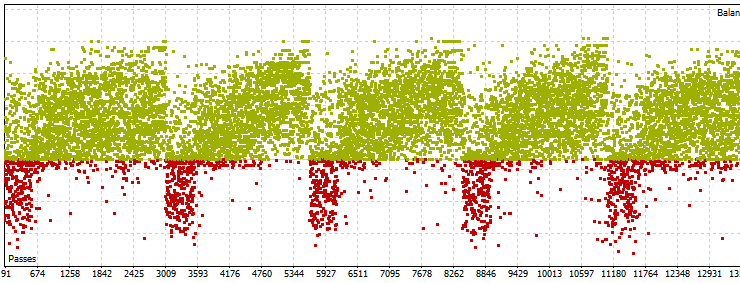
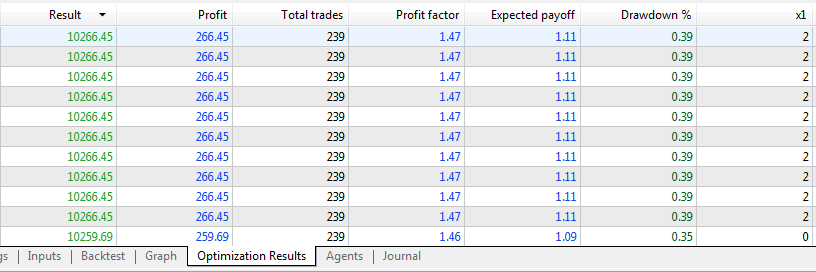
Una vez completada la optimización, generaremos un archivo en formato CSV usando Excel. Permítanme recordarles que hemos tomado los primeros 50 mejores resultados. Para realizar las pruebas, pegaremos el archivo resultante en el código del segundo asesor. En código se verá así.
string EURUSD[][8]= { {"Profit","Trades","x1","x2","x3","x4","Param"}, {"266.45","239","2","1","9","8","5000"}, {"266.45","239","2","1","9","13","5000"}, {"266.45","239","2","1","9","11","5000"}, {"266.45","239","2","1","9","10","5000"}, {"266.45","239","2","1","9","8","5000"}, {"266.45","239","2","1","9","12","5000"}, {"266.45","239","2","1","9","20","5000"}, {"266.45","239","2","1","9","14","5000"}, {"266.45","239","2","1","9","2","5000"}, {"266.45","239","2","1","9","3","5000"}, {"259.69","239","0","0","12","17","5500"}, {"259.69","239","0","0","12","8","5500"}, {"259.69","239","0","0","12","1","5500"}, {"259.69","239","0","0","12","9","5500"}, {"259.69","239","0","0","12","16","5500"}, {"259.69","239","0","0","12","18","5500"}, {"259.69","239","0","0","12","11","5500"}, {"259.69","239","0","0","12","7","5500"}, {"259.69","239","0","0","12","15","5500"}, {"259.69","239","0","0","12","8","5500"}, {"259.69","239","0","0","12","9","5500"}, {"259.69","239","0","0","12","17","5500"}, {"259.69","239","0","0","12","6","5500"}, {"259.69","239","0","0","12","15","5500"}, {"259.69","239","0","0","12","4","5500"}, {"259.69","239","0","0","12","7","5500"}, {"259.69","239","0","0","12","11","5500"}, {"259.69","239","0","0","12","14","5500"}, {"259.69","239","0","0","12","1","5500"}, {"259.69","239","0","0","12","5","5500"}, {"259.69","239","0","0","12","3","5500"}, {"259.69","239","0","0","12","0","5500"}, {"259.69","239","0","0","12","12","5500"}, {"259.69","239","0","0","12","16","5500"}, {"259.69","239","0","0","12","8","5500"}, {"259.69","239","0","0","12","10","5500"}, {"259.69","239","0","0","12","16","5500"}, {"259.69","239","0","0","12","18","5500"}, {"259.69","239","0","0","12","13","5500"}, {"259.69","239","0","0","12","9","5500"}, {"259.69","239","0","0","12","12","5500"}, {"259.69","239","0","0","12","11","5500"}, {"259.69","239","0","0","12","7","5500"}, {"259.69","239","0","0","12","15","5500"}, {"259.69","239","0","0","12","14","5500"}, {"259.69","239","0","0","12","3","5500"}, {"259.69","239","0","0","12","19","5500"}, {"259.69","239","0","0","12","0","5500"}, {"259.69","239","0","0","12","17","5500"}, {"259.69","239","0","0","12","2","5500"} };
También ofreceremos el código del segundo asesor para comerciar. Como podemos ver, en un ciclo, revisaremos todos los valores obtenidos durante la optimización y los compararemos con los resultados actuales de la ejecución del perceptrón. Si los valores coinciden, se abrirá la posición de compra o venta correspondiente. El límite en el número de posiciones abiertas simultáneamente estará controlado por el parámetro MaxSeries y la función CalculateSeries, que calculará las posiciones mediante comentarios.
for(int i=1; i<=(ArraySize(EURUSD)/8)-1; i++) { comm=(EURUSD[i][0]+EURUSD[i][1]); x1=(int)StringToInteger(EURUSD[i][2]); x2=(int)StringToInteger(EURUSD[i][3]); x3=(int)StringToInteger(EURUSD[i][4]); x4=(int)StringToInteger(EURUSD[i][5]); Param=(int)StringToInteger(EURUSD[i][6]); //SELL++++++++++++++++++++++++++++++++++++++++++++++++ if((NewOpen==true) && (CalculateSeries(Magic)<MaxSeries) && (perceptron1()<-Param) && (CalculatePositions(symbolS1.Name(), Magic, POSITION_TYPE_SELL, EAComment+" En_"+comm)==0) && (SpreadS1<=MaxSpread)) { OpenSell(symbolS1.Name(), LotsXSell, TP, SL, EAComment+" En_"+comm); } //BUY++++++++++++++++++++++++++++++++++++++++++++++++ if((NewOpen==true) && (CalculateSeries(Magic)<MaxSeries) && (perceptron1()>Param) && (CalculatePositions(symbolS1.Name(), Magic, POSITION_TYPE_BUY, EAComment+" En_"+comm)==0) && (SpreadS1<=MaxSpread)) { OpenBuy(symbolS1.Name(), LotsXBuy, TP, SL, EAComment+" En_"+comm); } }
//+------------------------------------------------------------------+ //| Calculate Positions | //+------------------------------------------------------------------+ int CalculateSeries(ulong mag) { int total=0; string com=""; for(int i=PositionsTotal()-1; i>=0; i--) { if(position.SelectByIndex(i)) { if(position.Magic()==mag) { if(com!=position.Comment()) { com=position.Comment(); total++; } } } } //--- return(total); }
Resultado de la prueba retrospectiva:

Resultado de la prueba forward:

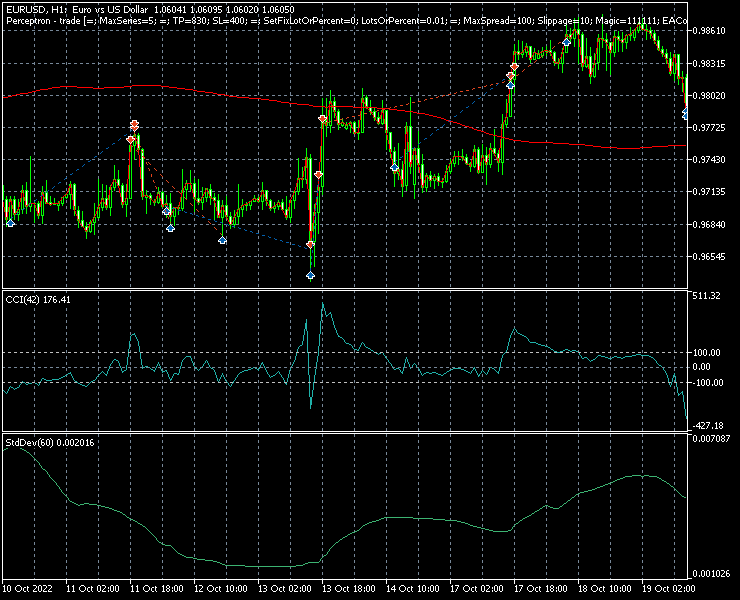
Conclusión
La lista de archivos adjuntos:
- Distance 1, Distance 2, Distance 3 son asesores con ejemplos de transmisión de distancias al perceptrón;
- Accumulation 1, Accumulation 2 son asesores con ejemplos de transmisión de acumulación al perceptrón;
- Angle 1, Angle 2 son asesores con ejemplos de transmisión de ángulos de inclinación del indicador al perceptrón;
- Combo 1 es un asesor con un ejemplo de transmisión de datos de indicadores combinados al perceptrón;
- Perceptron – opt es el asesor de optimización;
- Perceptron – trade es el asesor para el comercio con los parámetros optimizados.
Como podemos ver en los resultados de las pruebas forward, nuestro enfoque para transmitir indicadores funciona bien. Durante los primeros seis meses, el asesor aumenta el balance con bastante confianza. Más arriba en el artículo hemos ofrecido todo tipo de ejemplos de transmisión de indicadores: creo que a mis lectores les interesará probarlos. Esta vez hemos trabajado mucho, pero siempre hay algo por lo que luchar.
Para cualquier pregunta, puede contactar con el autor en el foro o por mensajes privados. Siempre estaré feliz de ayudarle.
Traducción del ruso hecha por MetaQuotes Ltd.
Artículo original: https://www.mql5.com/ru/articles/13598
Advertencia: todos los derechos de estos materiales pertenecen a MetaQuotes Ltd. Queda totalmente prohibido el copiado total o parcial.
Este artículo ha sido escrito por un usuario del sitio web y refleja su punto de vista personal. MetaQuotes Ltd. no se responsabiliza de la exactitud de la información ofrecida, ni de las posibles consecuencias del uso de las soluciones, estrategias o recomendaciones descritas.
 Características del Wizard MQL5 que debe conocer (Parte 07): Dendrogramas
Características del Wizard MQL5 que debe conocer (Parte 07): Dendrogramas
 Redes neuronales: así de sencillo (Parte 60): Online Decision Transformer (ODT)
Redes neuronales: así de sencillo (Parte 60): Online Decision Transformer (ODT)
 Redes neuronales: así de sencillo (Parte 61): El problema del optimismo en el aprendizaje por refuerzo offline
Redes neuronales: así de sencillo (Parte 61): El problema del optimismo en el aprendizaje por refuerzo offline
 Trabajamos con fechas y horas en MQL5
Trabajamos con fechas y horas en MQL5
- Aplicaciones de trading gratuitas
- 8 000+ señales para copiar
- Noticias económicas para analizar los mercados financieros
Usted acepta la política del sitio web y las condiciones de uso
Nuevo término en el trading : Canbles:-)
Corregir los errores tipográficos Candles! de la palabra Candle, a través d
Nuevo término en el comercio: Canbles:-)
Corregir los errores tipográficos Candles! de la palabra Candle, a través d
Corregido. Gracias por la observación )
Corregido.
No arreglé nada. Sigue siendo Canbles.
Definitivamente ya están corregidos todos los lugares del artículo.
Gracias por el mensaje.
Ahora definitivamente todos los lugares en el artículo han sido corregidos.
Gracias por el mensaje.
Muchas gracias.